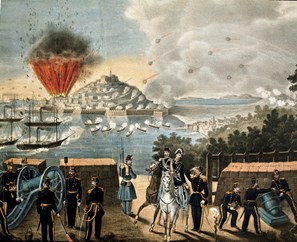Bombardment of Gaeta, February 5, 1861.
Battle of Calatafimi, painting from 1860 .
Garibaldi arrived in Naples by train with six companions and was received with great fanfare. The Garibaldini-now 20,000 men of the Southern Army-marched to the left bank of the Volturno River. The Bourbon army stood on the opposite bank with 25,000 men, preparing to recapture Naples.
Francis II still commanded 40,000 loyal men and looked for immediate assistance. This was not too difficult as Garibaldi, in a speech in Naples, announced his intentions to march on Rome, sweeping the French garrison out. This created a significant problem for Cavour. The French would intervene in such an event, and indeed, Austria could do the same. Franco-Austrian intervention would mean the end of the Italian Risorgimento. Cavour knew it and decided to prevent Garibaldi from fulfilling his pledge. As Cavour feared France more than he did Austria, he warned Napoleon III about a possible Mazzini initiative against the pope-Mazzini was in Naples-and told the French emperor that Piedmontese involvement was the best way to save the Papal States from the Republican menace.
Napoleon was not stupid and did not believe this story, but an extended and friendly Italian state would be better than nothing. Moreover, he was a former carbonaro who had spent his youth in Italy, and surely this played a role in his decision. He grumbled to the Piedmontese ambassador, “Faites, mais faites vite!” (“Do, but do quickly!”), and so the Piedmontese army intervened.
To reach Garibaldi, Piedmontese troops had to cross the Papal States, but Cavour needed a pretext. He demanded that the papal secretary of state, Cardinal Antonelli, disarm foreign units in papal service. On September 11, Rome responded in the negative, and Turin ordered the troops to move. Two corps, IV and V, crossed the border. As they were not at war strength, they consisted only of 30,000 men. French general Lamoricie`re commanded 20,000 papal soldiers, divided into three columns.
The Piedmontese acted quickly. V Corps crossed the Tuscan-Umbrian border and seized Perugia on September 14. It was defended by Swiss general Schmidt with 1,800 men. Then the corps marched to the Adriatic to join IV Corps. IV Army Corps, commanded by General Cialdini, marched down the Adriatic coast and on September 13 he defeated Swiss general De Courten’s column. Five days later his 4,800 men of the vanguard beat papal troops near Castelfidardo. Of 6,800 papal soldiers, 88 died, 3,000 retreated to Loreto, 3,600 were captured, and the few remaining escaped to Ancona together with Lamoricie`re. Both Piedmontese corps met at Ancona. The city was besieged by land and sea and, after terrible shelling, the 350 officers and 7,000 men of the garrison surrendered on September 29.
On October 1, not far from Naples, the Garibaldini achieved their last victory. At dawn the Bourbon army attacked. Lamoricie`re-coordinated the offensive, foreseeing a large encircling maneuver being made against the Garibaldini. Garibaldi had two advantages: He could move his troops faster than the enemy by using interior lines of operations, and he could receive reinforcements due to the railway connecting Naples to Caserta. The Bourbon generals employed merely 25,000 men, instead of the 40,000 they had at their disposal, and thereby lost their superiority in numbers. Garibaldi put 20,000 men in the field and gained the victory.
The failure of the Bourbon offensive meant the end of Neapolitan independence. The Piedmontese army was marching south. Victor Emmanuel had entered Abruzzo and, after a skirmish at Macerone, he met Garibaldi in Teano on October 26. Soon after this meeting, the regular army took over operations. Capua was besieged by V Corps and capitulated on November 2, while IV Corps marched to the Tyrrhenian coast. After crossing the Garigliano River on November 3, the 1st Infantry Division attacked and routed 20,000 soldiers at Mola di Gaeta, later known as Formia. A portion of them entered the southern Papal States and surrendered to the French troops watching the border. The others remained in Gaeta with Francis II, his court, and the foreign ambassadors.
Cialdini blockaded the city with 16,000 men, and Admiral Persano did the same by sea. The city, garrisoned by 12,000 men, was methodically shelled, day after day, by Piedmontese artillery, now using for the first time the Cavalli rifled cannons. On February 12, 1861, Francis II signed the capitulation and sailed to the papal port of Civitavecchia on a French ship. While Bourbon garrisons in Civitella del Tronto and Messina still resisted, the Parliament met at Turin on February 18, as the Parliament of the Kingdom of Italy. They proclaimed Victor Emmanuel II king of Italy “by the Grace of God and by the Will of the Nation.”
